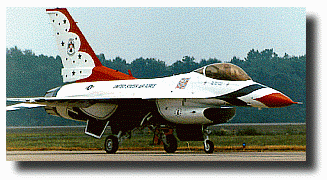
The F- 16 Fighting Falcon is one of the U.S. Air Force's frontline jet fighter aircraft. Since its introduction in 1976, the F- 16 has made its mark as a true multirole fighter. Its highly maneuverable design has proven itself in air-to-air combat and air-to-ground attack. This aircraft provides arelatively low-cost, high-performance weapons system for the air forces of the free world.
In an air combat role, the F-16's maneuverability and combat radius (distance it can enter aircombat, stay, fight, and return) exceed that of all potential threat fighter aircraft. It can locate targets in all weather conditions and detect low flying aircraft in radar ground clutter. In the air-to-ground role, the F-16 can fly more than 500 miles, deliver its weapons with superior accuracy, defend itself against enemy aircraft, and return to its origin base. An all-weather capability allows it to accurately deliver ordnance during non-visual bombing conditions.
In designing the F-16, advanced aerospace technology and proven reliable systems from other aircraft were selected. These were combined to simplify the jet and reduce its size, weight, purchase price, and maintenance costs. The light weight of the fuselage is achieved without reducing its strength. The F-16 can withstand up to nine G's (nine times the force of gravity) with its internal fuel tanks filled -- greater than any other current fighter aircraft. The cockpit and its bubble canopy are designed to give the pilot unobstructed forward and upward vision, and greatly improved vision overthe side and to the rear. The seat-back angle was expanded from a standard 13 degrees to 30 degrees, increasing pilot comfort and G-force tolerance. The pilot has excellent flight control of the F-16 through its "fly-by-wire" system. Electrical wires relay commands, replacing the cables and linkage controls. For easy and accurate control of the aircraft during high G-force combat maneuvers, a side-stick controller is used instead of the conventional center-mounted stick. Hand pressure on the side-stick controller sends electrical signals to actuators of flight control surfaces suchas ailerons and rudder.
Avionics systems include a highly accurate inertial navigation system in which a computerprovides global positioning and steering information to the pilot. The plane uses UHF and VHF radios plus an instrument landing system. It also has a radio/threat warning system and modular counter measure pods to be used against airborne or surface electronic threats. The fuselage also has space for additional avionics systems .
All F-16s delivered since November 1981 have built-in structural and wiring provisions and systems architecture that permits expansion of the jet's multirole flexibility to perform precision strike, night-attack and beyond-visual-range interception missions. This improvement program led to the F-16C/D aircraft, which are the single and two-place counterparts to the F-1 6A/B, respectively, and incorporate the latest cockpit control and display technology.
Now serving at U.S. Air Force bases worldwide, the Fighting Falcon is also flown by the Air National Guard and Air Force Reserve. In addition, the F-16 is a vital part of the air forces of Belgium, Denmark, Netherlands, Norway, Israel, Egypt, Korea, Pakistan, Venezuela, Turkey, Greece, Singapore, Thailand, Indonesia, and Bahrain. The worldwide use of the F- 16 truly makes it a mainstay of international tactical air forces.